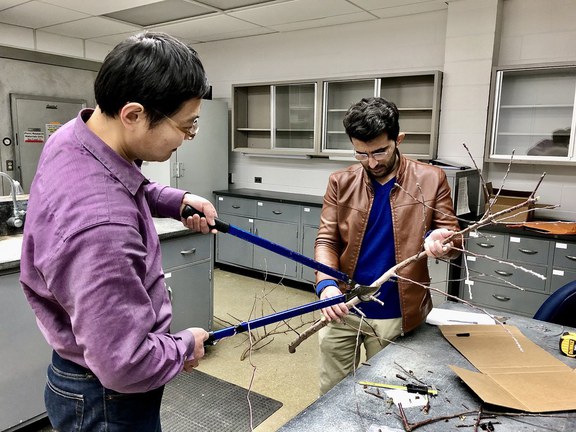Novel pruning system can provide automated, cost-effective solutions to ease challenges facing tree-fruit growers.
Problem
What can be done to help tree-fruit growers struggling with increasing labor shortages and high associated costs?
- In the U.S., apples are one of the most valuable specialty crops, contributing about $3 billion to the tree-fruit industry.
- Pruning apple trees, necessary for profitable quality and quantity, requires about 31 working hours of skilled manual labor per acre, comprising about 20 percent of total pre-harvest production costs.
Findings
Researchers designed an automated, computerized pruning system for modern apple orchards, integrating a pruning compact robotic arm with two rotational joints and three linear joints to be able to operate in tight spaces and orient itself at almost all possible angles to reach any branch.
- Field tests assessed the performance of the prototype, finding that the cutting mechanism, or "end-effector," successfully cut branches up to an inch in diameter and at a wide range of orientations.
Impact
Automated solutions such as this innovative end-effector can provide growers with cost-effective alternatives when labor pools are limited. The introduction of robotics into agriculture reduces the burden of repetitive manual processes and opens new career pathways for agricultural workers.
Research Credit
Team
- Azlan Zahid, Md Sultan Mahmud, Long He, Daeun Choi, Paul Heinemann, James Schupp
Participating Departments
Partner
Competitive Funding
- USDA NIFA (NE SARE)
Federal and State Appropriations
- USDA NIFA Hatch Multistate Project PEN04547, Accession #1001036
Emerging Discoveries
Published Research
Development of an integrated 3R end-effector with a cartesian manipulator for pruning apple trees
-
Zahid, A., Mahmud, M. S., He, L., Choi, D., Heinemann, P., & Schupp, J. (2020). Development of an integrated 3R end-effector with a cartesian manipulator for pruning apple trees. Computers and Electronics in Agriculture, 179, [105837]. https://doi.org/10.1016/j.compag.2020.105837
Office for Research and Graduate Education
Address
217 Agricultural Administration BuildingUniversity Park, PA 16802-2600
- Email agresearch@psu.edu
- Office 814-865-3136
Office for Research and Graduate Education
Address
217 Agricultural Administration BuildingUniversity Park, PA 16802-2600
- Email agresearch@psu.edu
- Office 814-865-3136



